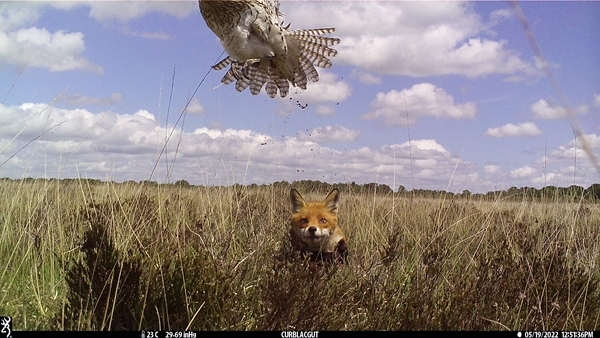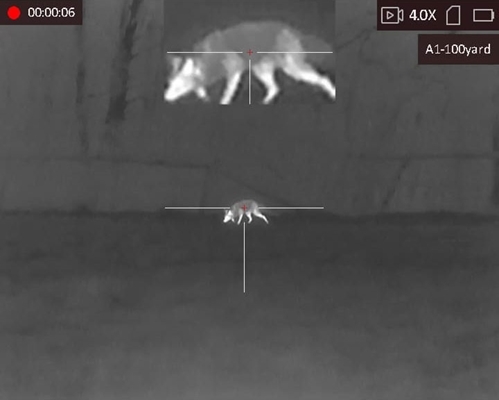By Mike Short, Head of Predation Control Studies
After two consecutive years of intensive curlew nest monitoring in the New Forest, it’s now clear that foxes pose the greatest threat to curlew nest survival in our study area. Of the 41 curlew nests monitored with cameras in 2021 and 2022, 25 failed due to predation, and 17 of these were attributed to foxes.
But that’s not to say that lawful control of other species – like carrion crows – isn’t important, for they have also been recorded predating nests, and in other regions where fox densities are much lower, nest predation by stoats could be the biggest threat.
 In the New Forest, our nest camera research shows that foxes are the principal predator of curlew nests.
In the New Forest, our nest camera research shows that foxes are the principal predator of curlew nests.
Protecting curlew nests in lowland heath: challenges and solutions
Our nest sample size is rather small, but with a fast-declining breeding curlew population (circa 33 breeding pairs recorded in 2022), and an expansive area of lowland heath in which to search for nests, it’s the best we could muster. However, it seems our results are fairly representative of the situation in other lowland curlew breeding areas, where foxes are usually reported as the principal predator of curlew nests.
For example, in one recent published study in Breckland, East Anglia, between 2019 and 2021, up to 80 pairs of curlews were studied annually across eight different sites. Over this three-year period, 136 nests were monitored, and 84 nests failed.
Of these, predation accounted for 86% of nest failures. Nest cameras weren’t used to identify predators in this study, but temperature loggers in nests showed that most predation events occurred at night, and foxes were assumed to have been the main culprit. Here, the authors suggest that electric fencing could help improve nest survival by preventing mammalian predators – principally foxes – from predating nests at night.
In the New Forest, the use of electric fencing to protect curlew nests is not a viable option, and likely never will be. In this complex landscape, finding nests is extremely time-consuming. The birds breed on ‘open access’ lowland heath and wet mires, where commoners graze cattle and ponies.
Fences of any description are the virtual antithesis of commoner rights, and on one private land-holding where the gamekeeper urgently wanted to use a temporary electric fence to protect a vulnerable curlew nest, Natural England made his request so problematic that the fencing route can be off-putting.
 Intensive fox culling at night has led to greatly improved curlew and lapwing nest survival.
Intensive fox culling at night has led to greatly improved curlew and lapwing nest survival.
Lawful culling essential to reduce fox predation on curlew nests in New Forest
As it stands, in the New Forest, the only viable way of reducing fox predation pressure on curlew nests is by lawful culling, both prior to and during the critical incubation phase. Our curlew nest camera studies show that of the 17 nests predated by foxes, 11 were lost during the third week of May, which coincides with increasing fox prey-food demands as cubs are reared and when most first or early-second clutches are likely to be hatching.
For foxes, the extra cheeping noise that’s emitted from hatching curlew eggs can give their location away, so it’s a precarious time, and vital that fox predation pressure has been adequately supressed prior to this critical stage of the nesting period.
Alongside our curlew nest monitoring work, we have been collecting predator culling records from wildlife managers across the New Forest National Park. The area involved now includes over 33,000 ha of predator-managed land, with detailed records on fox culling effort and bag data provided by shoot tenants, gamekeepers, and Forestry England personnel.
One objective of this important research is to determine what level of fox culling effort is required to improve curlew nest survival and ultimately, productivity. Although in its infancy, it’s already revealing what level of fox culling effort improves nest survival, and what doesn’t.
For example, during the 2022 curlew breeding season, on one management unit, 7 out of 9 monitored curlew nests hatched. One nest was destroyed by crows after the adults mysteriously disappeared, and the other nest was lost to a domestic dog – our first documented dog incident in two years of wader nest camera monitoring. To say this represents impressive nest survival is an understatement, but it took a great deal of hard work.
Between 1 April and the end of May, the small team involved put in over 200 hours of dedicated fox management work, and fox sighting rates had more than halved by the third week in May, indicating greatly reduced predation pressure.
The result was at least 24 curlew chicks leaving their nest-cups but sadly, many of these perished, so understanding why chick survival in the New Forest is so poor, despite first-class legal predation management occurring right through the breeding and fledging period, is our next curlew research priority.
Although it’s just a few years old, contrary to the conclusions of the RSPB’s controversial Curlew Trial Management Project, the GWCT’s curlew and predation research in the New Forest is showing that targeted culling of foxes (and carrion crows) greatly improves curlew (and lapwing) nest survival, which is the first-step towards generating more wild-born curlew in their natural breeding areas.
Where electric fencing is not a viable management option, or where finding curlew nests is too problematic, this is what many breeding curlew populations desperately need:commitment by skilled and motivated wildlife managers prepared to go the extra mile for the birds they’re trying to protect.
Given the now large numbers of people involved – and new Defra funding for curlew recovery projects in the English lowlands – regional populations could stabilise and grow if the most site-appropriate predation management actions are implemented immediately.
But time is running out; these long-lived birds urgently need new recruits. Head-starting curlew chicks only buys time, and is pointless unless breeding site managers address the fundamental current problems of poor nest and chick survival. The GWCT plays an active role in UK curlew conservation efforts through its research, advisory, training and policy work, and with the Curlew Recovery Partnership.
However, through discussions with those who work on the ground to conserve breeding curlew on a day-to-day basis, there is clearly rising concern there has been rather a lot of curlew-talking over the past few years, but insufficient action: lots of curlew monitoring, but not enough protection. If curlew are to hang on in the English lowlands, then it’s imperative that wildlife managers act now to improve the breeding success of these magnificent birds.